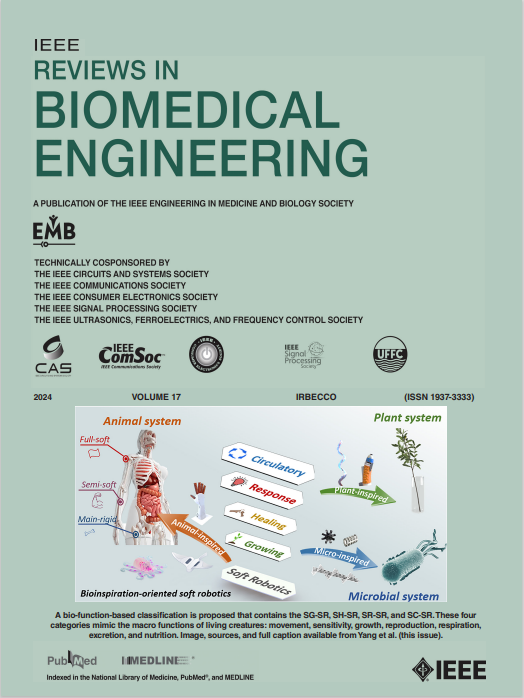Earable Multimodal Sensing and Stimulation: A Prospective Toward Unobtrusive Closed-Loop Biofeedback
IF 17.2
1区 工程技术
Q1 ENGINEERING, BIOMEDICAL
引用次数: 0
Abstract
The human ear has emerged as a bidirectional gateway to the brain's and body's signals. Recent advances in around-the-ear and in-ear sensors have enabled the assessment of biomarkers and physiomarkers derived from brain and cardiac activity using ear-electroencephalography (ear-EEG), photoplethysmography (ear-PPG), and chemical sensing of analytes from the ear, with ear-EEG having been taken beyond-the-lab to outer space. Parallel advances in non-invasive and minimally invasive brain stimulation techniques have leveraged the ear's access to two cranial nerves to modulate brain and body activity. The vestibulocochlear nerve stimulates the auditory cortex and limbic system with sound, while the auricular branch of the vagus nerve indirectly but significantly couples to the autonomic nervous system and cardiac output. Acoustic and current mode stimuli delivered using discreet and unobtrusive earables are an active area of research, aiming to make biofeedback and bioelectronic medicine deliverable outside of the clinic, with remote and continuous monitoring of therapeutic responsivity and long-term adaptation. Leveraging recent advances in ear-EEG, transcutaneous auricular vagus nerve stimulation (taVNS), and unobtrusive acoustic stimulation, we review accumulating evidence that combines their potential into an integrated earable platform for closed-loop multimodal sensing and neuromodulation, towards personalized and holistic therapies that are near, in- and around-the-ear.可听的多模态传感和刺激:对不显眼的闭环生物反馈的展望
人的耳朵已经成为大脑和身体信号的双向通道。耳戴式和耳内式传感器的最新进展使得利用耳脑电图(ear- eeg)、光体积脉搏描记术(ear- ppg)和耳分析物的化学传感来评估来自大脑和心脏活动的生物标志物和生理标志物成为可能,耳脑电图已被带出实验室,进入外太空。在非侵入性和微创性脑刺激技术的平行发展中,利用耳朵对两个脑神经的访问来调节大脑和身体的活动。前庭耳蜗神经以声音刺激听觉皮层和边缘系统,迷走神经耳支间接但显著地耦合自主神经系统和心输出量。声学和电流模式刺激使用谨慎和不显眼的可穿戴设备是一个活跃的研究领域,旨在使生物反馈和生物电子医学在诊所之外交付,远程和连续监测治疗反应性和长期适应。利用耳脑电图、经皮耳迷走神经刺激(taVNS)和不引人注目的声刺激的最新进展,我们回顾了积累的证据,这些证据将它们的潜力结合到一个集成的可耳平台上,用于闭环多模态传感和神经调节,朝着个性化和整体治疗的方向发展,这些治疗是在耳内、耳内和耳周围进行的。
本文章由计算机程序翻译,如有差异,请以英文原文为准。
求助全文
约1分钟内获得全文
求助全文
来源期刊

IEEE Reviews in Biomedical Engineering
Engineering-Biomedical Engineering
CiteScore
31.70
自引率
0.60%
发文量
93
期刊介绍:
IEEE Reviews in Biomedical Engineering (RBME) serves as a platform to review the state-of-the-art and trends in the interdisciplinary field of biomedical engineering, which encompasses engineering, life sciences, and medicine. The journal aims to consolidate research and reviews for members of all IEEE societies interested in biomedical engineering. Recognizing the demand for comprehensive reviews among authors of various IEEE journals, RBME addresses this need by receiving, reviewing, and publishing scholarly works under one umbrella. It covers a broad spectrum, from historical to modern developments in biomedical engineering and the integration of technologies from various IEEE societies into the life sciences and medicine.
 求助内容:
求助内容: 应助结果提醒方式:
应助结果提醒方式:


